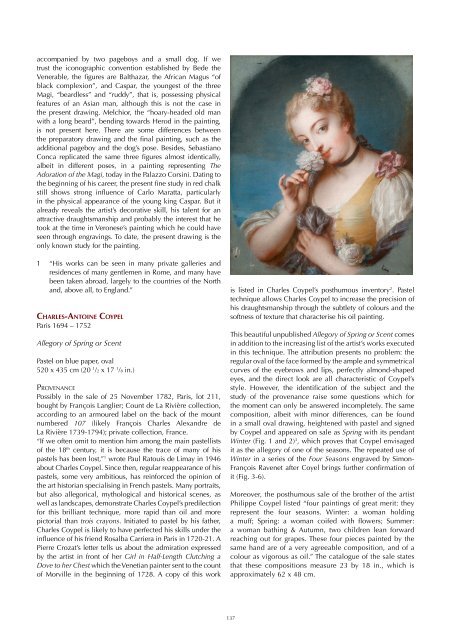You also want an ePaper? Increase the reach of your titles
YUMPU automatically turns print PDFs into web optimized ePapers that Google loves.
accompanied by two pageboys <strong>and</strong> a small dog. If we<br />
trust the iconographic convention established by Be<strong>de</strong> the<br />
Venerable, the figures are Balthazar, the African Magus “of<br />
black complexion”, <strong>and</strong> Caspar, the youngest of the three<br />
Magi, “beardless” <strong>and</strong> “ruddy”, that is, possessing physical<br />
features of an Asian man, although this is not the case in<br />
the present drawing. Melchior, the “hoary-hea<strong>de</strong>d old man<br />
with a long beard”, bending towards Herod in the painting,<br />
is not present here. There are some differences between<br />
the preparatory drawing <strong>and</strong> the final painting, such as the<br />
additional pageboy <strong>and</strong> the dog’s pose. Besi<strong>de</strong>s, Sebastiano<br />
Conca replicated the same three figures almost i<strong>de</strong>ntically,<br />
albeit in different poses, in a painting representing The<br />
Adoration of the Magi, today in the Palazzo Corsini. Dating to<br />
the beginning of his career, the present fine study in red chalk<br />
still shows strong influence of Carlo Maratta, particularly<br />
in the physical appearance of the young king Caspar. But it<br />
already reveals the artist’s <strong>de</strong>corative skill, his talent for an<br />
attractive draughtsmanship <strong>and</strong> probably the interest that he<br />
took at the time in Veronese’s painting which he could have<br />
seen through engravings. To date, the present drawing is the<br />
only known study for the painting.<br />
1 “His works can be seen in many private galleries <strong>and</strong><br />
resi<strong>de</strong>nces of many gentlemen in Rome, <strong>and</strong> many have<br />
been taken abroad, largely to the countries of the North<br />
<strong>and</strong>, above all, to Engl<strong>and</strong>.”<br />
Charles-Antoine Coypel<br />
Paris 1694 – 1752<br />
Allegory of Spring or Scent<br />
Pastel on blue paper, oval<br />
520 x 435 cm (20 1 /2 x 17 1 /8 in.)<br />
Provenance<br />
Possibly in the sale of 25 November 1782, Paris, lot 211,<br />
bought by François Langlier; Count <strong>de</strong> La Rivière collection,<br />
according to an armoured label on the back of the mount<br />
numbered 107 (likely François Charles Alex<strong>and</strong>re <strong>de</strong><br />
La Rivière 1739-1794); private collection, France.<br />
“If we often omit to mention him among the main pastellists<br />
of the 18 th century, it is because the trace of many of his<br />
pastels has been lost,” 1 wrote Paul Ratouis <strong>de</strong> Limay in 1946<br />
about Charles Coypel. Since then, regular reappearance of his<br />
pastels, some very ambitious, has reinforced the opinion of<br />
the art historian specialising in French pastels. Many portraits,<br />
but also allegorical, mythological <strong>and</strong> historical scenes, as<br />
well as l<strong>and</strong>scapes, <strong>de</strong>monstrate Charles Coypel’s predilection<br />
for this brilliant technique, more rapid than oil <strong>and</strong> more<br />
pictorial than trois crayons. Initiated to pastel by his father,<br />
Charles Coypel is likely to have perfected his skills un<strong>de</strong>r the<br />
influence of his friend Rosalba Carriera in Paris in 1720-21. A<br />
Pierre Crozat’s letter tells us about the admiration expressed<br />
by the artist in front of her Girl in Half-Length Clutching a<br />
Dove to her Chest which the Venetian painter sent to the count<br />
of Morville in the beginning of 1728. A copy of this work<br />
is listed in Charles Coypel’s posthumous inventory 2 . Pastel<br />
technique allows Charles Coypel to increase the precision of<br />
his draughtsmanship through the subtlety of colours <strong>and</strong> the<br />
softness of texture that characterise his oil painting.<br />
This beautiful unpublished Allegory of Spring or Scent comes<br />
in addition to the increasing list of the artist’s works executed<br />
in this technique. The attribution presents no problem: the<br />
regular oval of the face formed by the ample <strong>and</strong> symmetrical<br />
curves of the eyebrows <strong>and</strong> lips, perfectly almond-shaped<br />
eyes, <strong>and</strong> the direct look are all characteristic of Coypel’s<br />
style. However, the i<strong>de</strong>ntification of the subject <strong>and</strong> the<br />
study of the provenance raise some questions which for<br />
the moment can only be answered incompletely. The same<br />
composition, albeit with minor differences, can be found<br />
in a small oval drawing, heightened with pastel <strong>and</strong> signed<br />
by Coypel <strong>and</strong> appeared on sale as Spring with its pendant<br />
Winter (Fig. 1 <strong>and</strong> 2) 3 , which proves that Coypel envisaged<br />
it as the allegory of one of the seasons. The repeated use of<br />
Winter in a series of the Four Seasons engraved by Simon-<br />
François Ravenet after Coyel brings further confirmation of<br />
it (Fig. 3-6).<br />
Moreover, the posthumous sale of the brother of the artist<br />
Philippe Coypel listed “four paintings of great merit: they<br />
represent the four seasons. Winter: a woman holding<br />
a muff; Spring: a woman coifed with flowers; Summer:<br />
a woman bathing & Autumn, two children lean forward<br />
reaching out for grapes. These four pieces painted by the<br />
same h<strong>and</strong> are of a very agreeable composition, <strong>and</strong> of a<br />
colour as vigorous as oil.” The catalogue of the sale states<br />
that these compositions measure 23 by 18 in., which is<br />
approximately 62 x 48 cm.<br />
137
















